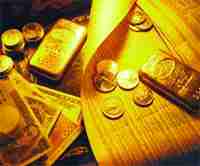Gold Price Fix
How the price of gold is fixed and the history of gold prices & currency.
How the price of gold is set.
The process
for setting the price of gold is called 'Gold Fixing'. It is also referred to as the Gold Fix or London Gold Fixing
since it is set on the London gold market by the five-member London Gold Pool. The object is to fix a price for
settling contracts in the London gold bullion
market and was first done in 1919 among the top five gold traders but the price so fixed in
US dollars (USD), Pound sterling (GBP) and Euros (EUR) per troy ounce is now recognized informally throughout the
world as the gold price benchmark.
The gold fix is done twice a day, AM and PM, at the Barclay's Bank today but until 2004,
was done by the Rothschild organization in London. Bidding is begun by the chairman of the 5-member group with a
'try' price over the telephone and market members then say how much they are willing to buy or sell at that price.
If the demand for gold at the time is greater than the supply, the price is adjusted upwards until demand and
supply balance each other and vice versa. The price is fixed at this point. Sometimes, there may be no agreement on
supply and demand and in those rare occasions, the chairman can fix the price at his discretion. The PM fix is
usually considered the main reference price for the day that is used in gold transactions.
Other factors that influence gold price
It is estimated that all the
gold ever mined totals 158,000 tons and though the price is fixed depending on supply and demand, it is possible
that the supply at any time is this entire hoard of gold because the whole amount can theoretically be offered for
sale. When the amount of existing gold is compared to the amount of gold being produced every year, it becomes
clear that the price is set mainly on the prevailing sentiment at any given time. If for example, a destabilizing
financial and political situation like war leads dealers to feel that their currency assets (paper money) may
become worth less, a solid asset such as gold will increase in price. This happened during the Great Depression in
the 1930s to the extent that the American government made it illegal to own gold. The demand for gold will also
increase if the returns on other investments like stocks and bonds become very low as happened during the
stagflation years of the 1970s which led to an investment bubble in the price of gold and other precious metals
like silver. Similar, though not as extreme conditions have forced gold prices to reach a new, decades-long high.
The uncertainties of today's global financial system which is interconnected and interdependent like at no time in
history cause many to feel that not just individuals but governments will stock up on gold and drive the price even
higher as they rush to bolster their non-financial assets thus introducing fear and speculation into the pricing
equation.
The gold standard and Bretton Woods System
This was a commitment by participating countries to set the price of gold in their domestic currencies so that
these currencies could be easily and freely converted to gold and vice versa. The Gold Standard Act of 1900 brought
in the gold standard and it was ended in 1933 when President Roosevelt make it unlawful to own gold other than in
the form of jewelry because people had lost faith in currency during the Great Depression. This was replaced by The
Bretton Woods System of 1946 after World War Two which created a system of fixed rates that let governments sell
their gold to the US. This system ended in 1971 when President Nixon ended it, ending for the first time the link
between currencies and commodities. Today, we use the system of 'fiat money' which says that currency is
intrinsically worth only the paper it is printed on is is used only as a medium of exchange for the supply and
demand of goods and services in an economy, including precious metals like gold and silver, with the value of money
allowed to fluctuate based on market forces.
The fascinating history and mechanism by which gold is priced via the gold price fix is
part of the mystique of investing in gold, whether in the form of mutual funds, ETFs, coins or bars.
| 